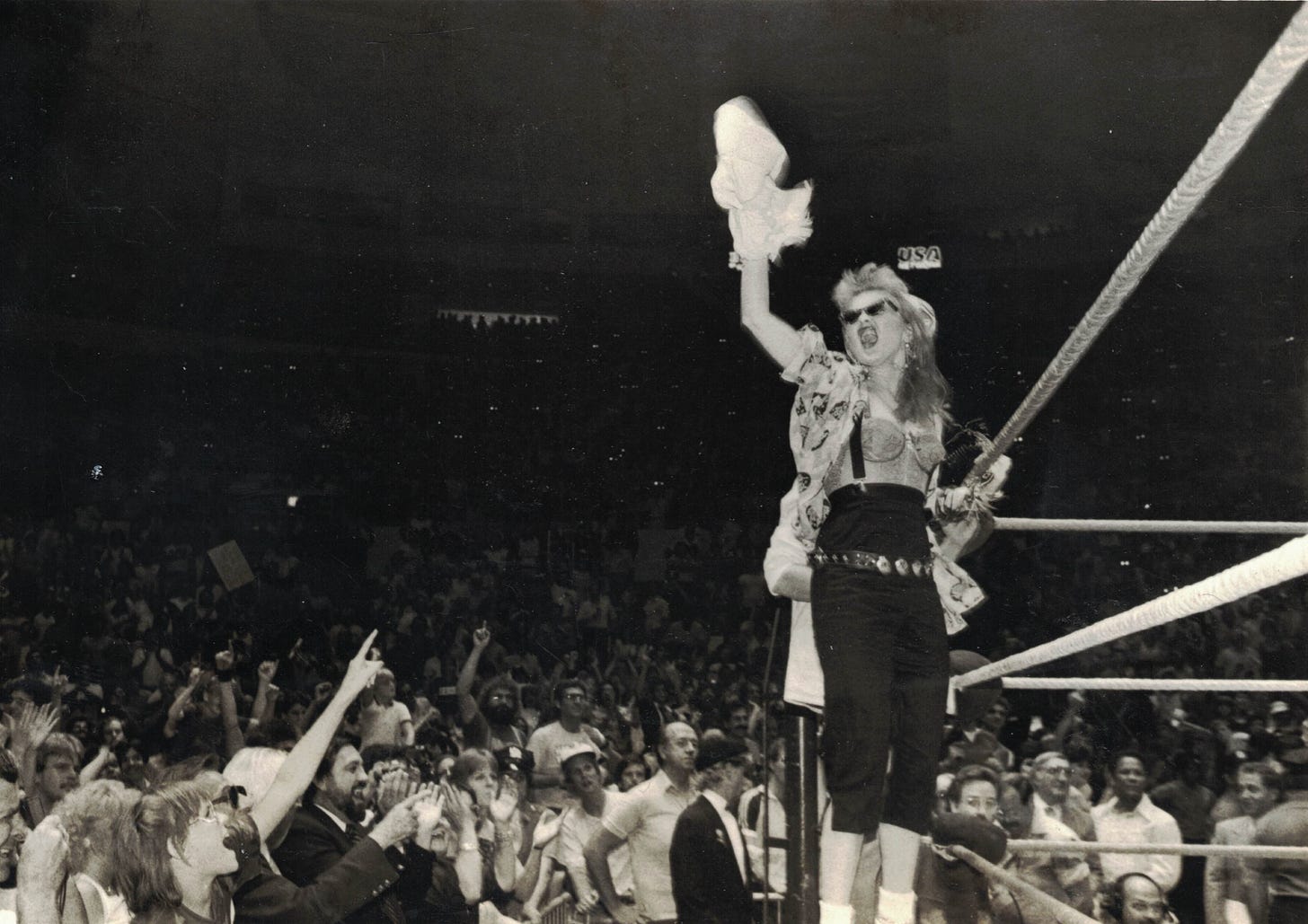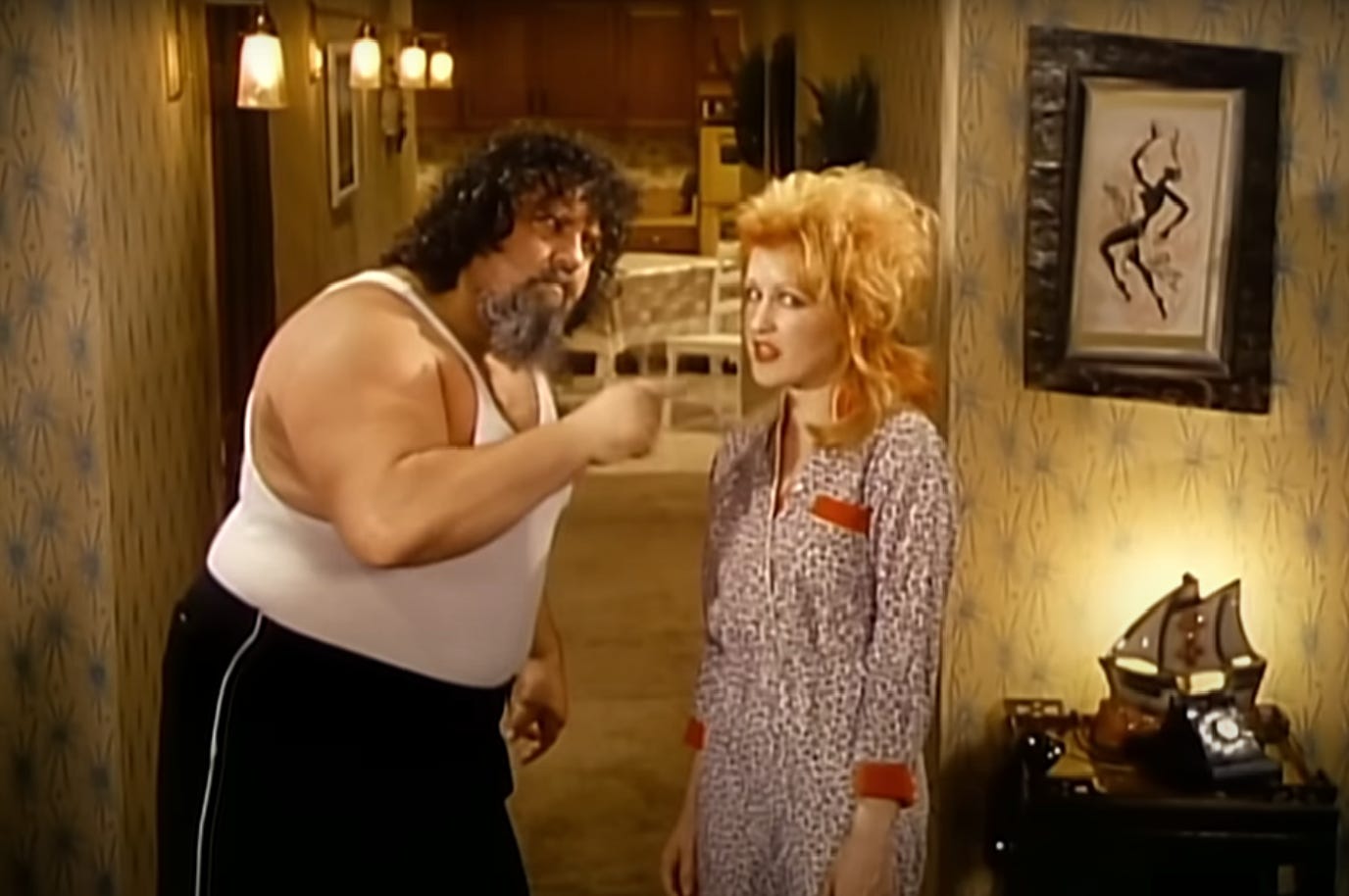What the Kayfabe?
I witness the Brawl to End it All
© 2023 David Potorti
“The Brawl to End it All” captured a moment when championship wrestling, pop stars and MTV played well together. It happened at New York’s Madison Square Garden on July 23rd, 1984, and pitted musician Cyndi Lauper against wrestling manager Captain Lou Albano through their proxies in the ring: Lauper’s was the stupendously buff Wendi Richter, in bubblegum pink, and Albano’s was The Fabulous Moolah, the matronly defender of the World Wrestling Federation (WWF)’s Women’s Championship.
© 2023 David Potorti
A photographer that night, I crouched between the ring and the cattle pens walling in the crowd with my elbows on the mat. It was during a lead-in bout between Greg Valentine and Hulk Hogan that I learned how much crap—giant pretzels, crumpled soda cups— got hurled into the ring by fans during the wrestlers’ introductions. I also learned what became of the debris: the wrestlers happily kicked it out of the ring and into our faces, so I spent a good deal of time ducking. At one point, even the wrestlers tumbled out of the ring, threatening to pitch folding chairs at each other.
The main event was broadcast live on MTV during a brief and very successful period of intersection between the WWF and the (then) three year-old music channel. Lauper had met Albano on a flight to Puerto Rico, and invited him to appear as her father in the “Girls Just Want to Have Fun” video in 1983. (Lauper included WWF characters in several subsequent videos). An invented dispute over Albano’s sexism turned them against each other.
“He’s crazy that guy, I’m tellin’ you, he’s a slug, an amoeba,” explained Lauper.
The internet did not exist in the eighties, but The Brawl can be viewed online today. I had never watched it before, but spotted myself, alert for airborne pretzels, by the edge of the ring, my Canon AE-1 SLR and boat-sized Vivitar Thyristor hot shoe flash unit in hand. Lauper could still shock with her red hair and crazy Memphis Group colors, and Albano’s face is covered in rubber bands, one around his beard and others hanging from piercings, a public nod toward his support of the fight against multiple sclerosis.
© 2023 David Potorti
With play-by-play from longtime announcers “Mean Gene” Okerland and Gorilla Monsoon, the 20-minute fight is a masterpiece of choreography, storyline and invented drama: “The Fabulous Moolah is choking, flagrantly and blatantly, Wendy Richter,” shouts Gene. At one point, Moolah gets tangled in the ropes, hanging upside-down like a trussed turkey for more than a minute. “That had to take a lot out of her, those ropes are extremely tight,” Okerland remarks.
The commentary is uncommonly clinical. “A reverse chin lock with a knee right in the upper cervical vertebra, and that is painful,” observes Gene. “Oh, a head butt to the lower abdominal region of the champion.”
Richter lifts Moolah and slams her to the canvas.
“What a suplex!” declares Gorilla. “What a tremendous suplex!” adds Gene.
At different moments, Lauper and Albano take shots at the opposing wrestlers from the sidelines. And when she loses to Richter in a controversial decision, “The Fabulous One” puts her boots to the referee, kicking him out of the ring.
© 2023 David Potorti
Still, no one got hurt.
It’s “kayfabe,” the act of portraying staged acts as real, that makes championship wrestling such a hoot to watch; everyone’s in on it, and even if you’re not, it’s still a uniquely satisfying performance of good versus evil. I didn’t follow the sport, but back in the day I had a cousin who fancied model airplanes, liked to fix cars, and happily recounted the exploits of Sgt. Slaughter, Rowdy Roddy Piper and Tito Santana. Championship wrestling truly is a sport of the people.
In a great 2018 post by journalist Matt Taibbi, Controversy Creates Cash, or how the Trump era has turned the news business into Wrestlemania, he asserts that Donald Trump’s natural kayfabe skills have played a role his success.
An autobiography written by Eric Bischoff with Jeremy Roberts, Controversy Creates Cash describes Bischoff’s career as a professional wrestling promoter and personality, and details the utter seriousness behind crafting years-long storylines for the personalities. There’s the baby face and there’s the heel, and great wrestlers play those roles to the hilt, relishing the crowd’s praise as well as its jeers.
Apparently, Trump is a heel with a core audience that sees him as a baby face.
But as far as the WWF (now World Wrestling Entertainment, WWE) is concerned, one thing is indisputably real: the wrestlers are exceptional athletes, and extraordinary performers. And, one might add, good role models. The cameras came backstage after The Brawl to witness the celebration.
“Any woman can get what she wants, if she wants it bad enough,” says Cyndi. “All she has to do is try hard.”
“And believe in herself, you got to believe in yourself,” adds Wendi.
“You ladies must be reading the Leo Buscaglia books,” sneers Gene.
Buscaglia was a pop psychology author who was a fixture on PBS pledge drives.
What a tremendous suplex!










Thank you for that hilarious history lesson in female wrestling!
Awesome! Keep 'em coming (sans pretzels and soda cups though)!